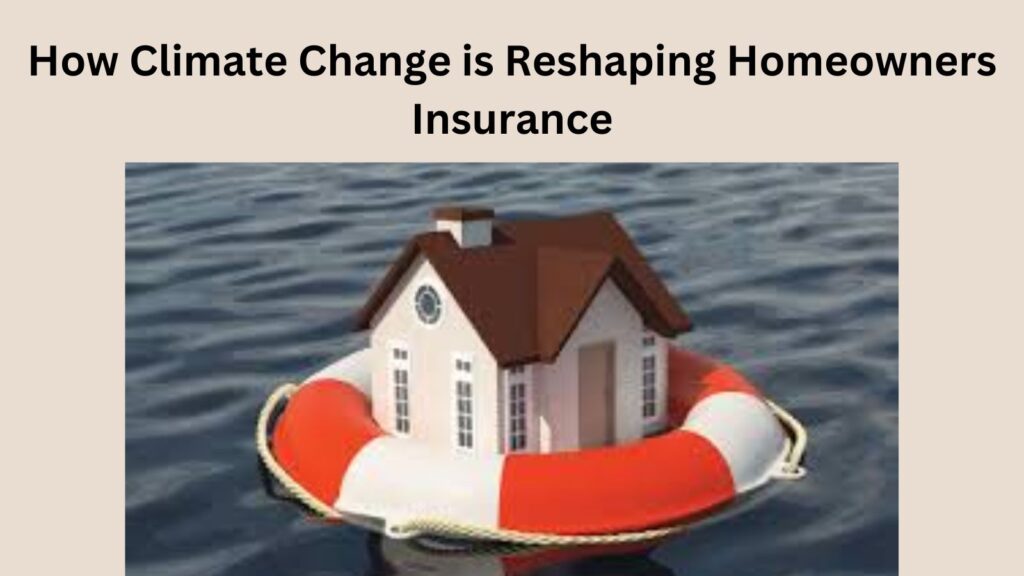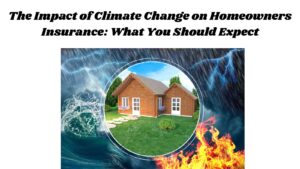Recently, the world has faced more natural disasters. We’ve seen deadly hurricanes, fierce wildfires, and record-setting floods. The culprit? Climate change. As our climate changes, extreme weather events are more common and intense. This shift is changing how homeowners view insurance coverage.
Gone are the days when homeowners insurance was just about covering damage from everyday mishaps. More homeowners in storm-prone areas are now asking if their insurance covers damage from climate events. Are you, as a homeowner, truly covered against the threats posed by climate change? How is the insurance industry adjusting to this growing risk?

This article looks at how climate change is changing homeowners insurance. This is especially true in areas at risk for floods, hurricanes, and wildfires. We’ll also explore new products, like climate-risk insurance. We’ll discuss if your current policy is enough to protect you.
The Rise of Extreme Weather Events and Their Impact on Homeowners Insurance
Contents
- 1 The Rise of Extreme Weather Events and Their Impact on Homeowners Insurance
- 2 How Climate Change is Impacting Homeowners Insurance Coverage
- 3 Emerging Products: Climate-Risk Insurance and Other Solutions
- 4 Real-Time Example: California Wildfires
- 5 Conclusion: Is Your Property Covered Against Climate Change?
- 6 Frequently Asked Questions
- 6.1 1. Is my homeowners insurance affected by climate change?
- 6.2 2. Does homeowners insurance cover flood damage?
- 6.3 3. How can I reduce my insurance premiums in a high-risk area?
- 6.4 3. How can I reduce my insurance premiums in a high-risk area?
- 6.5 4. Will my premiums continue to rise due to climate change?
Climate Change and the Surge in Natural Disasters
One of the most significant impacts of climate change is the increase in extreme weather events. A 2021 United Nations report shows that extreme weather events have increased a lot in the last 50 years. Floods, hurricanes, wildfires, and heatwaves are causing major damage worldwide. The report shows that natural disasters have quadrupled since the 1970s. Climate change is expected to make this worse in the next few decades.
Flooding: A Growing Threat
Flooding is one of the most common and destructive consequences of extreme weather. The National Flood Insurance Program (NFIP) reports a sharp increase in flood claims in the U.S. The Federal Emergency Management Agency (FEMA) notes that floods are occurring more frequently, and the damage is rising quickly.
Many homeowners think their standard insurance covers flooding. However, flood insurance is usually a separate policy. Many homeowners in flood-prone areas don’t have it. In fact, only about 12% of homeowners in the U.S. have flood insurance, despite the fact that floods cause significant damage to homes every year.
Hurricanes and Storm Surges: A Deadly Combination
Hurricanes, once limited to coastal regions, are becoming more intense and destructive due to climate change. The National Hurricane Center says warmer ocean temperatures create stronger storms. This results in higher storm surges that flood homes and cause millions in damage. Strong storms have led to higher insurance premiums for coastal homeowners. Now, they face rising costs to keep their coverage.
After Hurricane Katrina struck in 2005, the Insurance Information Institute (III) saw a rise in hurricane claims and insurance premiums. In 2020, the U.S. saw 30 named storms, the most on record. Homeowners and insurers now approach hurricane insurance differently. This change comes from more frequent and severe hurricanes.
Wildfires: A Growing Risk in the West
Wildfires are now a growing threat in many areas of the United States. While hurricanes and flooding get a lot of attention, wildfires are becoming more common. The U.S. Forest Service noted a huge rise in wildfires, especially in the West. In 2020, wildfires burned more than 10 million acres. California had one of its worst wildfire seasons ever that year.
These wildfires are not only destroying homes but also posing a massive challenge to the insurance industry. Many insurers are cutting coverage in high-risk wildfire areas. Others are raising premiums a lot to cover the added risk. Homeowners in wildfire areas are struggling. They deal with higher premiums or have trouble finding insurance.
How Climate Change is Impacting Homeowners Insurance Coverage
Insurance Premiums: Rising Costs Across the Board
As extreme weather events become more common, the cost of homeowners insurance is rising across the board. Insurers are adjusting their pricing models to reflect the increased risks posed by climate change. Homeowners in high-risk areas, like flood zones or wildfire regions, face rising premiums. This change helps cover the growing risk of disasters.
After Hurricane Katrina, many homeowners in Louisiana saw their insurance premiums double. This was because the risk of future storms increased. In wildfire-prone areas of California, premiums have soared. Insurers are trying to cover the rising costs of claims.
Coverage Gaps: What’s Not Covered?
Most homeowners policies cover wind and some water damage. However, there are still big gaps in coverage for natural disasters. Some key coverage gaps include:
- Flood Damage: Most standard homeowners insurance policies do not cover flood damage. Homeowners in flood-prone areas need separate flood insurance. They often get it from the National Flood Insurance Program (NFIP). However, this program has limits, like low payout caps for high-value homes.
- Wildfire Damage: Most standard policies cover fire damage, but they usually exclude damage from wildfires in some areas. Homeowners in high-risk wildfire areas are struggling to get full coverage because the risk is rising.
- Hurricane Damage: In some coastal regions, hurricanes may not be fully covered under standard policies. Hurricane deductibles are now more common. Homeowners have to pay a higher deductible for storm-related claims.
Underinsurance: The Risk of Insufficient Coverage
With premiums on the rise, many homeowners may find themselves underinsured in the face of a climate-related disaster. Many homeowners face underinsurance when they don’t buy enough flood or windstorm coverage. They often think their standard policy is enough. But as extreme weather events happen more often, the chance of them damaging homes also grows.
Rebuilding costs can go up a lot after a disaster. This happens because demand for labor and materials increases. Homeowners may end up with too little coverage if they don’t change their policy limits.
Emerging Products: Climate-Risk Insurance and Other Solutions
With rising climate change risks, the insurance industry is creating new products for homeowners. A promising development is climate-risk insurance. It uses climate data and models to evaluate how climate change affects individual properties.
What is Climate-Risk Insurance?
Climate-risk insurance helps homeowners protect their properties from climate change risks. Climate-risk insurance differs from standard homeowners insurance. Traditional policies cover general risks. In contrast, climate-risk insurance uses advanced climate models and data. This helps assess a property’s unique hazards, like flooding, wildfires, or severe storms.
Some companies now offer customized policies. These consider an area’s risk from rising sea levels, shifting rainfall, and higher temperatures. This helps homeowners get coverage for the specific risks their homes face from climate change.
How Can Homeowners Prepare for Climate-Related Risks?
- Flood Insurance: If you live in a flood-prone area, consider purchasing separate flood insurance. Even if you don’t live in a designated flood zone, it may be worth it if you’re at risk for flash floods or other flood-related disasters.
- Wildfire Insurance: Homeowners in wildfire areas need to check if their policies cover wildfire damage. They should also think about getting extra coverage if it’s offered.
- Hurricane Riders: If you live where hurricanes hit, make sure your policy covers hurricane damage well. Find insurance providers with hurricane riders. These riders give extra coverage for these events.
Real-Time Example: California Wildfires
In 2020, the U.S. West Coast faced a severe wildfire season. California alone had over 9,000 wildfires. These fires scorched more than 4 million acres of land. Many homeowners in affected areas saw their premiums rise or their policies dropped altogether. Some insurers started to offer climate-risk insurance. These products aim to tackle the growing threat of wildfires.
California’s State Compensation Insurance Fund now offers wildfire-specific coverage. This includes risk assessments. They look at how close homes are to fire-prone areas. They also check the fire resilience of properties. Homeowners who improve fire safety, such as making defensible spaces or using fire-resistant roofs, may pay lower premiums.
Conclusion: Is Your Property Covered Against Climate Change?
As climate change continues to fuel extreme weather events, homeowners insurance is evolving to meet the growing risks. While traditional homeowners policies may cover some aspects of damage caused by natural disasters, floods, hurricanes, and wildfires often require additional coverage or separate policies.
Emerging products like climate-risk insurance are beginning to offer more tailored coverage based on the specific climate risks your property faces, providing a more comprehensive safety net in an increasingly unpredictable world.
Homeowners must evaluate climate risks to their property. It’s important to make sure your insurance policy covers future disasters. If your home is located in a high-risk area, it may be time to explore specialized coverage options to ensure you’re fully protected.
MUST READ:
The Rise of Usage-Based Insurance: How Telematics is Changing Car Insurance
Frequently Asked Questions
1. Is my homeowners insurance affected by climate change?
Yes, climate change is causing an increase in extreme weather events like floods, hurricanes, and wildfires. Insurers are adjusting their premiums and coverage options to reflect these changing risks.
2. Does homeowners insurance cover flood damage?
Typically, standard homeowners insurance does not cover flood damage. You will need to purchase separate flood insurance to protect your property from flooding.
Take steps to reduce risk. For example, install fire-resistant roofing in areas prone to wildfires. You can also elevate your home to prevent flood damage. Some insurers offer discounts for risk reduction measures.
Take steps to reduce risk. For example, install fire-resistant roofing in areas prone to wildfires. You can also elevate your home to prevent flood damage. Some insurers offer discounts for risk reduction measures.
It’s likely that premiums will continue to rise in areas prone to extreme weather events as insurers adjust to increased risks. Exploring climate-risk insurance and reducing your home’s risk can help lower premiums.
